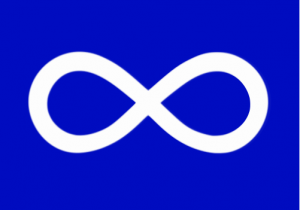This is a children’s book published in the Michif language. It’s quite a rarity, since less than a thousand people can speak the language. But the Métis community in Manitoba is determined to pass the language to the next generation. Michif is one of the most peculiar languages on the planet. It developed in Western Canada among the Métis people, and it combines a basically Cree grammar and verb system with many French nouns, adjectives and prepositions. A few stray English and Gaelic terms are in there, too. It does not follow the pattern of any other known creole, pidgin, or trade language. For example, it retains intact the extremely complex Cree verb morphology, which is the sort of thing that’s usually the first to go in a mixed language. Michif is a linguistic puzzle, without obvious parallel in any other linguistic or social situation. The only other language that is similar is Bungee, spoken by a very few Métis, in which Gaelic replaces French as the main source of nouns and adjectives. There are some people known to have been perfectly fluent in both Michif and Bungee — for example, James Isbister, a farmer in Saskatchewan who was selected as one of the four delegates (along with Gabriel Dumont) to recall Louis Riel from Montana to represent the Métis, was known to be fluent in both Michif and Bungee, as well as Cree, English, French, Gaelic, and the completely unrelated (and notoriously difficult) Dené language. ![]()
Neither Michif nor Bungee were ever spoken by a majority of Métis in Canada. French remained the most widely spoken language among them throughout most of their history, and it differs only moderately from the rather conservative form of Standard Canadian French spoken in Northern Ontario or the West. But Michif is respected as a distinctive element of Métis culture, like the peculiar Métis flag, which dates from 1815.
In fact, the book is about the flag:
“Lé Michif chéñ kekwiy izhitwáwin ayáwak?” kakwetwew Thomas. [Do the Métis people have anything cultural?” asked Thomas.]
“Wé, Thomas” itiko. [“Yes, Thomas,” she said.]
“Aeñ paviyóñ kitayán li bleu pi li bláñ nákwan ekwa aeñ siné ká nashpitak dañ la midjeu ahtew,” Omamawa itikó. [“We have our own flag. It’s blue and white and has an infinity symbol in the middle,” his mom explained.]
“Lé Michif tápwetamok la siné ká nashpitak dañ li paviyoñ itwe makan deu lé mónd ozhitwá winiwáwa e mamawinakik ekwa aká wékách chi ishkochimikoshichik, “ omamawa wétamáko. [“The Métis people believe that the infinity symbol on the flag stands for the joining of two cultures and the existence of a people forever.” his mom explained.]
The words in red are clearly (at least to me) French-derived. Other French elements may be there, but less obvious. For example, the Western Cree for “his mother” should be “okaya”. But Cree speakers often say “omammawa”. The French “mamman” may have been borrowed into Cree before the formation of Michif, or after, or at the same time. Some speakers of Michif would use the French word “puis” rather than the Cree word “ekwa” [“and now” or “along with”] in this sentence. Note that the Michif word for “flag” does not derive from the French word for flag (“drapeau”) but from “pavillon”, a more archaic word for a battle standard or a cloth banner. Many of the French elements differ considerably from the French which is simultaneously spoken by the same people. The words of Cree derivation are not identical to those used in speaking Cree, even though most Michif speakers are perfectly familiar with that language. [Compare Cree “nakatew” (to go away) with Michif ” shipwaytay”, Cree “nikamew” (to sing) with Michif “nakamouw”.] These features are among the most puzzling in the language, since they don’t follow the pattern found in other mixed languages, and creoles. Michif is definitely a true language, not a pidgin (a pidgin is never used domestically, cannot express a full range of ideas and feelings, and is limited to formal exchanges between different language communities). It’s status as a living language, no matter how small the number of speakers, is exemplified by the expression “Tápwesa miyonákwan” for “wow, this is cool” [from Cree: “Tapwe miyonakwan” (“truly beautiful”)] and by words borrowed from Zatilyeañ (Italian) such as “pizza” and “spaghette”, or from Shénwe (Chinese).

The flag they are talking about first appeared in 1815, when it was taken up by Métis who worked for the Northwest Company. It is assumed to be the “infinity” symbol, which is open to all sorts of abstract interpretations, though there is no way of knowing exactly what people meant by it at the time. Some claim that it incorporates the Scottish flag of St. Andrew’s Cross, with the bars folded around each other. Scottish names were more common among Michif speakers than French ones. A variant with the same symbol on a red, rather than a blue field, was sometimes flown by Métis who worked for the rival Hudson’s Bay Company. The blue one, which was carried at the Battle of Seven Oaks in 1816, seems to have always been more popular. It was not used during the uprisings of 1869–70 and 1885, where Louis Riel’s “buffalo” flag was employed. But it remained in folk memory until revived in the modern resurgence of Métis culture.
0 Comments.